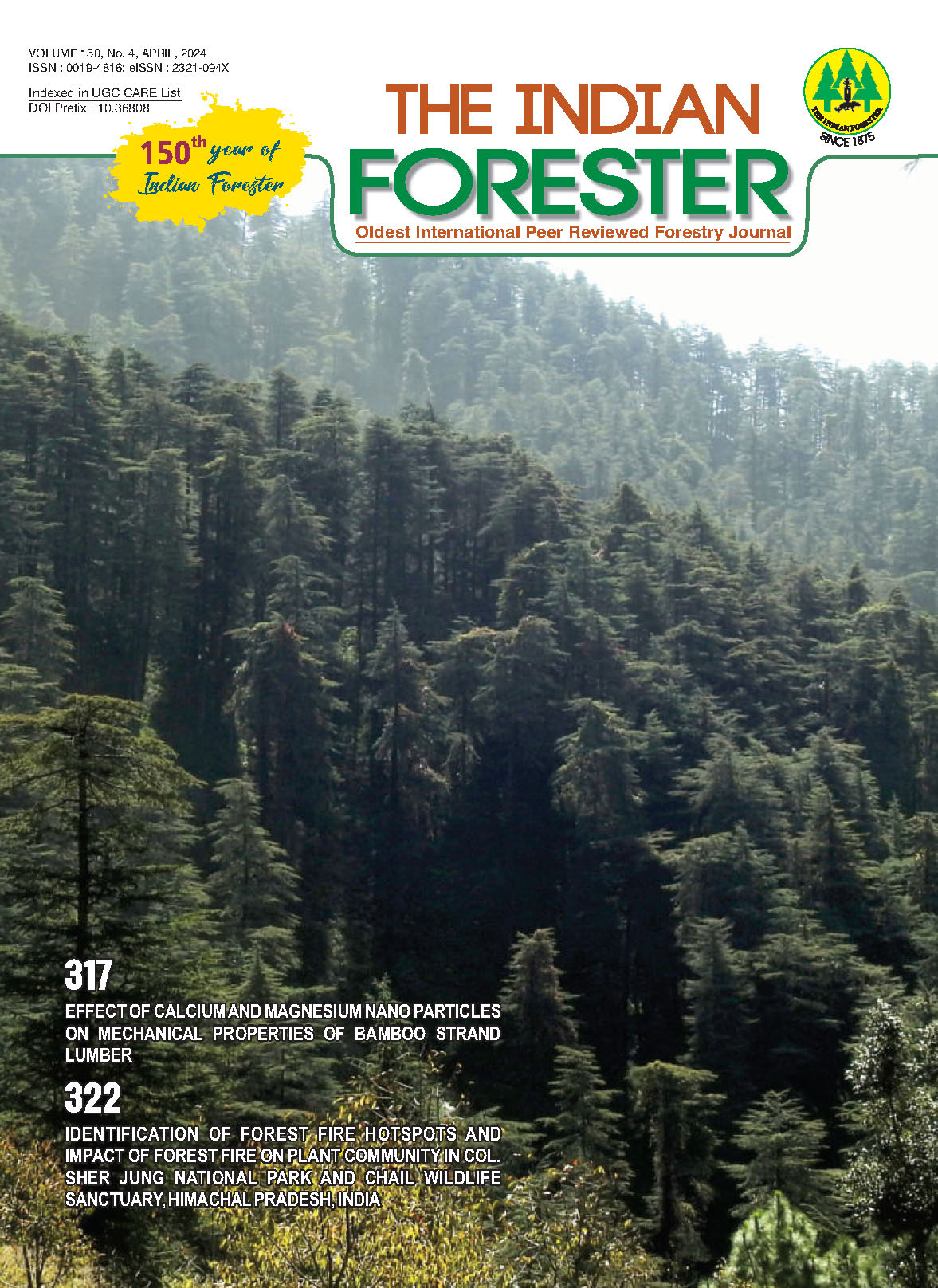Identification of Breeding Colonies of Lesser Adjutant Stork (Leptoptilos javanicus) Horsfield, 1821 in Jharkhand, India
DOI:
https://doi.org/10.36808/if/2024/v150i4/169883Keywords:
Breeding Colonies, Poaching, Lesser Adjutant Stork, Jharkhand.Abstract
A study was undertaken to investigate the occurrence of Lesser Adjutant Stork (Leptoptilos javanicus) (LAS) in different districts of Jharkhand during December 2022 to February 2023. The survey provided positive results with a record of four breeding colonies from the study. The first breeding colony was observed at Jamtara village in Giridih district with 6 nests, second breeding colony was observed at Thana Ckowkin Giridih district with 2 nests, the third and fourth breeding colonies were observed at Jarangdih village and Kodwadih village in Bokaro district with 5 and 2 nests respectively. The area is suitable for the species in terms of habitat, however anthropogenic threats still exist and require conservation interventions. Atotal number of 52 individuals and 15 nests of LAS were observed. Among 52 individuals 26 were fledglings/juveniles and 26 were adult individuals. Amongst the 15 breeding nests,9 were found on 5 different tall Bombax ceiba (Semal) trees and 6 on a single Ficus bengalensis (Bargad) tree. All the nests were occupied with fledglings ranging from one to two fledglings per nest. The largest breeding colony was observed on a single Ficus bengalensis (Bargad) tree at Jamtara village in Dumri block of Giridih district and the smallest breeding colony was observed on Bombax ceiba (Sembal) trees at Kodwadih village in Nawadih block of Bokaro district, that needs to be protected.References
Ali S. and Ripley S.D. (1978). Handbook of the Birds of India and Pakistan. Volume 1 (2nd ed.). New Delhi: Oxford University Press. pp. 107–109.
Baker E.C.S. (1929). Fauna of British India. Birds. Volume 6 (2nd ed.). London: Taylor and Francis. pp. 329–330.
Balasubramanian A. (2013). Jharkhand-At a Glance. 10.13140/RG.2.2.13083.98086.
Ball V. (1874). Avifauna of Chuti (Chhota) Nagpur division, Sw. frontier of Bengal. Stray Feathers, 2: 355–440.
Baral H.S. (2005). Surveys for Lesser Adjutant Leptoptilos javanicus in and around Koshi Tappu Wildlife Reserve, Nepal. Forktail, 21: 190-193.
Barua M. and Sharma P. (2005). The Birds of Nameri National Park, Assam, India. Forktail, 21: 15–126.
BirdLife International (2015). Annual Report: Birdlife International Tokyo (1 January-31 December 2015).
BirdLife International (2001). Threatened Birds of Asia: The BirdLife International Red Data Book. BirdLife International, Cambridge, UK.
BirdLife International (2011). Species factsheet: Leptoptilos javanicus. Downloaded from http://www.birdlife.org on 26.6.2010.
BirdLife International (2013). IUCN Red List for birds. Downloaded from http://www.birdlife.org on 04/03/2023).
BirdLife International (2017). Leptoptilos javanicus (amended version of 2016 assessment). The IUCN Red List of Threatened Species 2017: e.T22697713A110481858. http://dx.doi.org/10.2305/IUCN.UK.2017-1.RLTS.T22697713A110481858.en.
BirdLife International (2022). State of the world's birds: 2020 annual update. http://datazone.birdlife.org/2020-annualupdate?fbclid=IwAR0ndxaHyCJompEUMcGHgJV8__2XGFlHnO3mWUtNSVvhRSR jtjseKwKzCw.
Blanford W.T. (1898). The Fauna of British India. Birds. Volume 4. London: Taylor and Francis. pp. 374–375.
Choudhury A. (2000). The Birds of Assam. Gibbon Books and WWF India, Guwahati, India.
Choudhury A. (2006). Birds of Dibru-Saikhowa National Park and Biosphere Reserve, Assam, India. Indian Birds, 2(4): 95–105.
Del Hoyo J., Elliot A. and Sargatal J. (1992). Handbook of the Birds of the World. Lynx Editions. Barcelona, Spain.
Elliot A. (1994). "Order Ciconiiformes. Family Ciconiidae (Storks)". In del Hoyo, J.; A. Elliot; J. Sargatal (eds.). Handbook of the Birds of the World. Volume 1. Ostrich to Ducks. Barcelona, Spain: Lynx Edicions. pp. 436–465.
Hancock, James A., Kushan James A., Kahl M. and Philip. (1992) Storks, Ibises and Spoonbills of the World. Princeton University Press. ISBN 978-0-12-322730-0.
Inskipp C. and Baral H. S. (2010). Potential impacts of agriculture on Nepal birds. Our Nature, 8: 270-312. https://doi.org/10.3126/on.v8i1.4339.
Kahl M.P. (1970). "Observations on the breeding of storks in India and Ceylon". Journal of the Bombay Natural History Society, 67: 453–461.
Katuwal H.B., Rai J., Tomlinson K., Rimal B., Sharma H.P., Baral H.S., Hughes A.C. and Quan R.C. (2022). Seasonal variation and crop diversity shape the composition of bird communities in agricultural landscapes in Nepal. Agriculture, Ecosystems & Environment, 333:107973. https://doi.org/10.1016/j.agee.2022.107973.
Katuwal H.B., Zhang M., Baral H.S., Sharma H.P. and Quan R.C. (2021). Assessment of farmers' knowledge and perceptions towards farmland birds show the need of conservation interventions. Global Ecology and Conservation 27:e01563. https://doi.org/10.1016/j.gecco.2021.e01563.
Mishra A., Mandal J.N. and Ghosh T.K. (2004): Breeding of Lesser Adjutant from an unexplored area of Kosi region of N. Bihar. Newsletter for Birdwatchers, 44: 84.
Mitra A., Chatterjee C. and Mandal F.B. (2011). Synthetic chemical pesticides and their effects on birds. Research Journal of Environmental Toxicology, 5(2): 81-96. https://doi.org/10.3923/rjet.2011.81.96.
Pawar S. and Birand A. (2002). Asurvey of amphibians, reptiles and birds in northeast India. OBC Bulletin, 35: 11–13.
Pearce-Higgins J.W., Eglington S.M., Martay B. and Chamberlain D.E. (2015). Drivers of climate change impacts on bird communities. Journal of Animal Ecology, 84: 943-954. https://doi.org/10.1111/1365-2656.12364.
Prakash S., Mishra A., Dwivedi M., Mishra A.K., Ranjan M. and Raziuddin M. (2012): Avian diversity of Udhuwa Lake Bird Sanctuary (IBA), Sahibganj, Jharkhand, India. Columban J. Life Sci., 13(1&2): 57–71.
Rahmani A.R. (2012): Threatened Birds of India – Their Conservation Requirements. Indian Bird Conservation Network, Bombay Natural History Society, Royal Society for the Protection of Birds, BirdLife International and Oxford University Press. Pp. 358–363.
Subaraj R. and Lok A.F.S.L. (2009). "Status of the Lesser Adjutant (Leptoptilos javanicus) in Singapore". Nature in Singapore, 2: 107–113.
The Telegraph (2010). Villager rescues stork. Jamshedpur, June 13. http://www.telegraphindia.com/ 1100614/jsp/jharkhand/story_12561650.jsp#.
Downloads
Downloads
Published
How to Cite
Issue
Section
License
Unless otherwise stated, copyright or similar rights in all materials presented on the site, including graphical images, are owned by Indian Forester.





